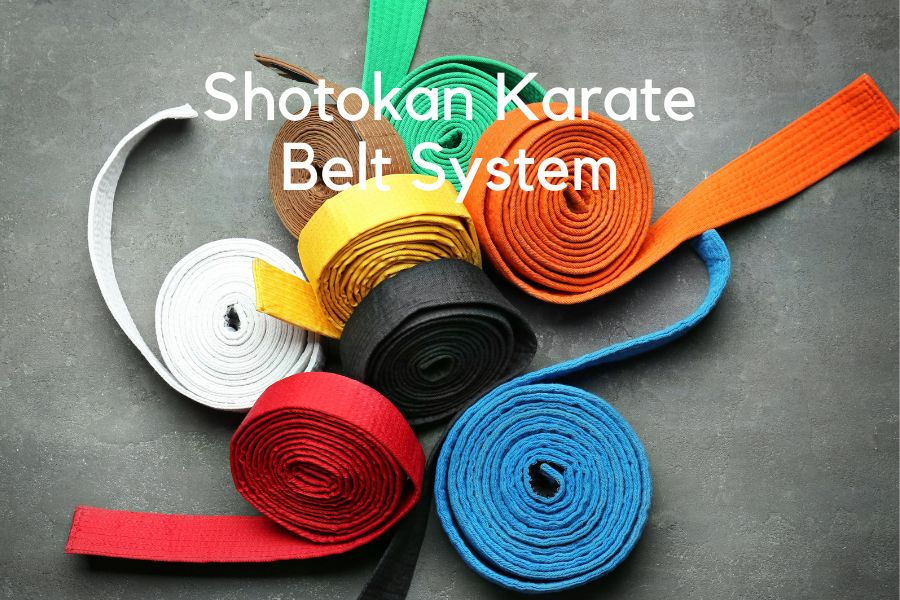If you’ve just joined a Shotokan dojo, this post will give you an overview of the Shotokan karate belt system.
If your goal is to get to the black belt level one day, this will give you the big picture of what lies ahead in your training, what you need to master, and how long it might take.
Even if belt colors don’t matter to you at all, this is still a useful overview of your karate journey.
Although Gichin Funakoshi never gave his style a name, Shotokan, the name of the first official dojo built by Gichin Funakoshi, in 1936, became the style’s name. Gichin Funakoshi appears to be the first one who awarded dans and ranks in karate having adopted the system from Judo.
However, Shotokan seems to be the most split-prone karate style in the world with many splits happening due to internal disputes. Today we have the Japan Karate Association (JKA), the Japan Karate Shotokai (JKS), Karate No Michi World Federation (KWF), the Japan Shotokan Karate Association (JSKA), the Shotokan Karate International Federation (SKIF) and many others.
Different Shotokan organizations may have slightly different belt systems, but the following (with 10 kyu and 10 dan levels) seems to be the most commonly adopted.
For more details on the grading requirements for each belt level, please click the hyperlink.
| Belt | Rank | Curriculum |
|---|---|---|
| White belt | 10th Kyu | Kihon: Basic punch and kick techniques and basic stances Kata: Heian Shodan Kumite: Gohon Kumite (Jodan and chudan) |
| White belt with one stripe | 9th Kyu | Minimum training time: 3 months or 25 training sessions Kihon: Basic punch and kick techniques and basic stances Kata: Heian Shodan Kumite: Gohon Kumite (Jodan and chudan) |
| Yellow belt | 8th Kyu | Minimum training time: 3 months or 25 training sessions Kihon: Basic punch and kick techniques and basic stances Kata: Heian Shodan Kumite: Sanbon kumite number 1 Ukemi waza: level 1 |
| Orange belt | 7th Kyu | Minimum training time: 3 months or 25 training sessions Kihon: Basic punch and kick techniques and basic stances Kata: Heian Nidan Kumite: Sanbon kumite number 2 Ukemi waza: level 2 |
| Green belt | 6th Kyu | Minimum training time: 4 months or 35 training sessions Kihon: intermediate kihon as requested Kata: Heian Sandan Kumite: Kihon Ippon Kumite (one technique each for Jodan, Chudan, Mae geri, Yoko geri, and Mawashi geri attacks) Ukemi waza: level 3 |
| Purple belt | 5th Kyu | Minimum training time: 4 months or 35 training sessions Kihon: intermediate kihon Kata: Heian Yondan Kumite: Kihon Ippon Kumite (two techniques each for Jodan, Chudan, Mae geri, Yoko geri, and Mawashi geri attacks) Ukemi waza: level 3 Fitness test: some dojos may include pushups, sit-ups, burpees, etc. |
| Purple belt | 4th Kyu | Minimum training time: 4 months or 35 training sessions Kihon: intermediate kihon Kata: Heian Godan Kumite: Kihon Ippon Kumite (two techniques each for Jodan, Chudan, Mae geri, Yoko geri, and Mawashi geri attacks) Ukemi waza: level 3 or higher Fitness test: some dojos may include pushups, sit-ups, burpees, etc. |
| Brown belt | 3rd Kyu | Minimum training time: 5-6 months or 40-50 training sessions Kihon: all basic techniques learned so far will be tested Kata: Tekki Shodan and a previous Heian kata on request Kumite: Kihon Ippon Kumite (one technique each for Jodan, Chudan, Mae geri, Yoko geri, and Mawashi geri attacks) Ukemi waza: level 3 or higher Fitness test: some dojos may include pushups, sit-ups, burpees, etc. |
| Brown belt | 2nd kyu | Minimum training time: 5-6 months or 40-50 training sessions Kihon: advanced kihon Sundome test at moment of de-ai for Kizami tsuki and Gyaku tsuki Kata: Bassai Dai and a previous Heian kata on request Kumite: Jyu Ippon Kumite (two techniques each for Jodan, Chudan, Mae geri, Yoko geri, Mawashi geri, Kizami tsuki and Gyaku tsuki attacks) Ukemi waza: level 3 or higher Fitness test: some dojos may include pushups, sit-ups, burpees, etc. |
| Brown belt | 1st Kyu | Minimum training time: 5-6 months or 40-50 training sessions Kihon: advanced kihon Sundome test at moment of de-ai for Kizami tsuki and Gyaku tsuki Kata: Kanku Dai and a previous Heian kata on request Kumite: Jyu Ippon Kumite (two techniques each for Jodan, Chudan, Mae geri, Yoko geri, and Mawashi geri attacks) Ukemi waza: level 3 or higher Fitness test: some dojos may include pushups, sit-ups, burpees, etc. |
| Black belt | 1st Dan | Minimum training time: 6 months after the last grading Kihon: advanced kihon Sundome test at the moment of de-ai for various tsuki and keri techniques Kata: all Heian kata and Tekki Shodan plus one advanced kata chosen among Bassai Dai, Kanku Dai, Empi and Jion Kumite: Jyu Ippon Kumite (show all techniques at three skill levels) Ukemi waza: level 3 or higher Essay: write an essay on any karate topic of no less than 3 pages to be handed in prior to the grading Fitness test: some dojos may include pushups, sit-ups, burpees, etc. |
| 2nd Dan | Minimum training time: 1 year after the last grading Kihon: advanced kihon Kime and sundome test at the moment of de-ai for various tsuki and keri techniques Kata: Shitei kata: all Heian plus Tekki Shodan Sentei kata: choose from Hangetsu, Tekki Nidan, Bassai Sho, Gankaku and Kanku Sho Kumite: Okuri Jyu Ippon Kumite and Jyu Ippon Kumite (facing two or more opponents in succession) Ukemi waza: level 3 or higher Essay: write an essay on a karate topic of no less than 5 pages to be handed in prior to the grading (Once you reach 2nd Dan, you can become an instructor at a branch or dojo) | |
| 3rd Dan | Minimum training time: 2 years after the last grading Kihon: advanced kihon as requested by the examiner Kime and sundome test at the moment of de-ai for various tsuki and keri techniques Kata: Shitei kata: Bassai Dai, Kanku Dai, Empi and Jion Sentei kata: choose from Sochin, Tekki Sandan, Chinte, Ji’in, Nijushiho, and Jitte Kumite: Jyu Kumite and Kaeshi Ippon Kumite Ukemi waza: level 3 or higher Essay: write an essay on any karate topic of no less than 8 pages to be handed in prior to the grading Teaching: substantial teaching experience required | |
| 4th Dan | Minimum training time: 4 years after the last grading Kihon: advanced kihon as requested by the examiner Kata: Shitei kata: Gojushiho Sho, Gojushiho Dai, Niju Shi Ho Sentei kata: choose from Sochin, Chinte, Ji’in, Gankaku Kumite: a) Develop, demonstrate, and teach original jyu ippon kumite combinations b) Self-defense c) Jyu kumite as requested Essay: write an essay on any karate topic of no less than 8 pages to be handed in prior to the grading Teaching: substantial teaching experience required | |
| 5th Dan | Minimum training time: 4-5 years after the last Kihon: Ido kihon in kamae as requested by the examiner Kata: from Heian Shodan to Tekki Sandan and a favorite kata Kumite: Jyu Kumite and Kaeshi Ippon Kumite Theory: write an essay on a technical aspect of karate and will be asked technical questions on at the grading | |
| 6th Dan | Minimum training time: 6 years after the last grading Kihon: as requested by the examiner Kata: from Heian Shodan to Bassai Dai plus Kanku Dai, Empi or Jion as specified by the examiner as well as a favorite kata Kumite: Jyu Kumite Theory: submit a report on techniques before the grading and will be asked questions on techniques at the grading | |
| 7th Dan | Minimum training time: 7 years after the last grading and must be 50 years old or over Kihon: as specified by the examiner Kata: student’s favorite kata Kumite: Jyu Kumite Theory: submit a report on techniques before the grading and will be asked questions on techniques at the grading | |
| 8-10th Dan | Honorary grading, recommended by the chief instructor, the head of the organization, or the executive committee 8th Dan: need at least 7 years since the previous grading and must be 60 years and over 9th Dan: need at least 8 years since the previous grading and must be recommended by the Instructor Committee 10th Dan: need at least 8 years since the previous grading and must be recommended by the Instructor Committee |
If you are interested in finding out more about the true origin of the karate belt and ranking system and the meanings of the belt colors, please check out this post.
As a general rule, if you are ready for the next grading, you will be asked by your instructor to grade and if he or she does not ask you, it means you are not yet ready.
If you don’t care about belts and rankings, just enjoy the journey and you will always be ready for whatever may come.
If your aim is to one day get to the black belt level, there is nothing wrong with that. But there is no need to rush, you will get there one day if you stay fully committed to your goal. Remember a blackbelt is a white belt who never quits.
Kyu gradings are normally conducted by your dojo instructors but all black belt gradings (apart from honorary dans) are generally conducted by an instructor committee comprised of the head instructor and other most senior instructors of the organization.
References
The JKA Kyu and Dan Rank Certification System
Shotokan Karate International Australia Grading Syllabus
Zanshin Shotokan Karate-do Grading Curriculum

